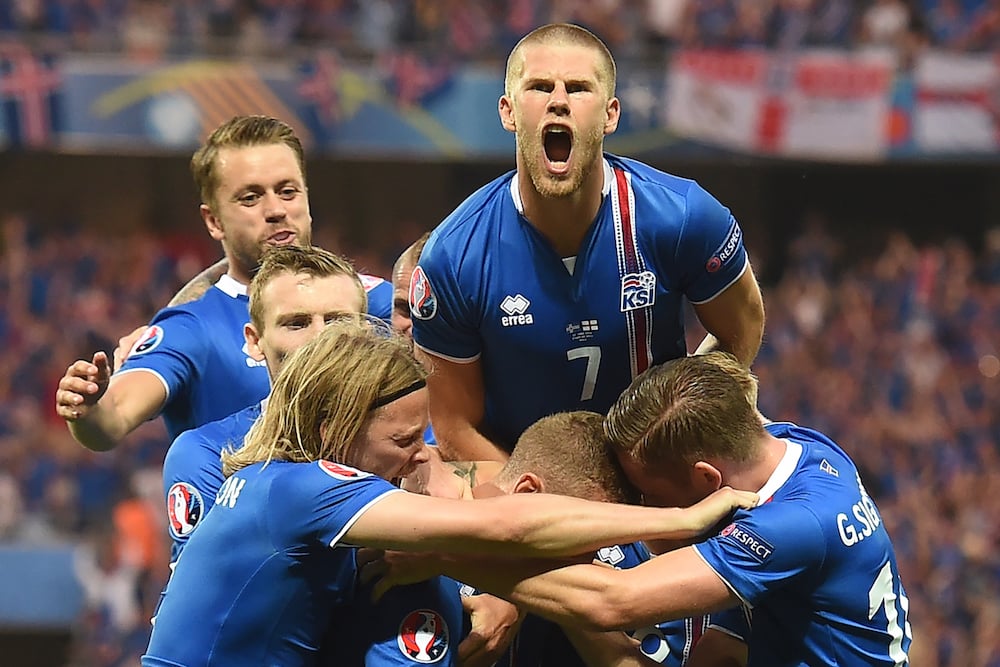How Iceland Became the World’s Next Soccer Powerhouse
A country of just 340,000 people is playing with the big boys.


Iceland’s population is roughly 340,000—the same as Santa Ana, California, or one one-thousandth of the number of people living in the United States. Almost everyone in the country’s only semi-pro soccer league has a part time job, and the national team’s head coach is a practicing dentist.
And yet that same national team qualified for this summer’s World Cup in Russia, whereas the U.S. did not. Iceland is ranked 18 in the FIFA rankings—just two spots below England and a seven ahead of the U.S., up from 133rd in 2012—and the team knocked England out of the 2016 European Championships. The squad, which plays a friendly match against Mexico Friday night in Santa Clara, California, and another against Peru next week in New Jersey, is already the Cinderella story of the 2018 World Cup.
How did this happen?
Iceland’s success is owed to a grand national experiment began in the early 2000s: A massive, government-led investment in youth soccer—in a well-organized club system, state-of-the art facilities, and certified paid coaches at all ranks—that stitched the sport into the fabric of the small island nation. You can barely drive a few blocks in Reykjavík, the capital, before coming across a soccer club. The country boasts as competitive national league, and some 75 Icelandic players are competing at top levels abroad (with another 20 in youth academies).
The idea is that the biggest number of kids should be able to practice the most amount of time possible at good facilities and under good coaches. That might seem novel (if a bit utopian), especially if you live in the U.S, where elite young players in any sport are nurtured and funneled upward at the expense of everyone else. But as Iceland’s soccer success shows, it works.
There’s no doubt the country is soccer obsessed. There are some 25,000 registered players at all levels. There are 90 official clubs—one 1 Division team, Grindavík, a town near Reykjavík, has a population of 2,697 and a soccer stadium that seats 1,750—and 600 coaches with international certification. All facilities are paid for with taxpayer money, and young players share the same facilities as the top-level players. Indoor fields mean players can train year-round, which is crucial in a country with a winter as long and dark as Iceland’s.
https://www.youtube.com/watch?v=LQmmfiNWMzo
All of the coaches get paid for their time, even if they’re coaching children as young as five. The semi-pro players get paid too, but not enough to play football full time; ninety-five percent of them have other jobs. (For perspective, the average English Premier League player makes $3.7 million a year.)
“There are positive things to being small. The coaches basically know the 50 best players in every age group,” says Dagur Dagbjarstsson, the coach education coordinator for Iceland’s national soccer association, the KFI. “Local coaches can just call up the national program and tell them if they’ve got a talented player.”
Indeed, Iceland is a very small place, and as such, during a short visit to report on soccer, our group of journalists met the country’s president. Not just the president of the soccer federation—we met him too—but the country’s actual president, Guðni Th. Jóhannesson. In his home.
Jóhannesson won the election not long before Iceland beat England in 2016. He won’t say which moment meant more to him. The soccer team is a tremendous source of pride in the country. “Sometimes you can turn the smallness into strength,” Jóhannesson says. “Being small means there’s a greater sense of togetherness.”
Because the country is so tiny, kids run into their idols in soccer clubs and on the streets. Jóhannesson says, “As kids, the dream of being a professional athlete, or representing the country, is much more realistic.”
https://www.youtube.com/watch?v=dzXSTMMAOjA
“There’s a strong emphasis on unity,” explains Guðni Bergsson, KSI’s president, who played professionally in England from 1988 to 2003 and is a national hero. “I like to think we’re a strong group together, from the stands onto the field and to management and coaches.”
That emphasis on unity means that, beginning from a young age, girls get the same treatment as boys, from practice time to quality of coaches. The women’s national team became successful before the men, and not long ago the KSI announced that women players would get the same bonuses as the men.
The success of Iceland’s national team also has to do with timing—the fact that right now, Iceland has a glut (relative to its size) of good players who play well together. The men are led by a gifted 28-year-old midfielder named Gylfi Sigurðsson, who plays pro in England for Everton.
Whether the team’s current success translates into a sustained reign will remain to be seen. Jón Rúnar Halldórsson, chairman of Reykjavík soccer powerhouse Fimleikafelag Hafnarfjardar, has his doubts: “It’s like the Beatles—the right people coming together and fitting. It’s not like some Harry Potter magic thing.”
For the fans, though, the state of Iceland soccer can feel a little magical. Before the national team’s home games, the coach/dentist Heimir Hallgrimsson shows up at the supporter’s bar to talk game strategy. (The only rule is that the conversation can’t be recorded.)
During games, fans scream the team’s unofficial chant—a thundering Viking cry called “the Hu”— which is now world famous and has been appropriated by fans of the Minnesota Vikings.
“When we were kids, if anybody said Iceland is going to the Euros, going to the World Cup—never gonna happen. Never going to happen,” says Benjamín Hallbjörnsson, chairman of the fan group Tolfan (which translates to ‘12th man’), who helped popularize the chant. “Well, we went to the Euros. Now, we’re going to the World Cup.”
In other words, anything can happen.
